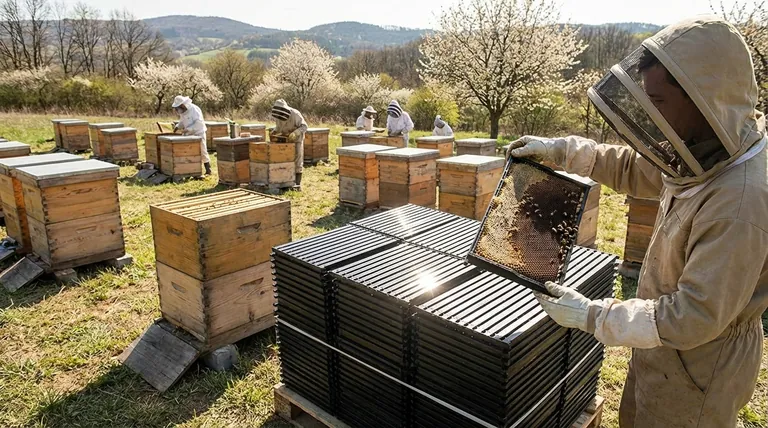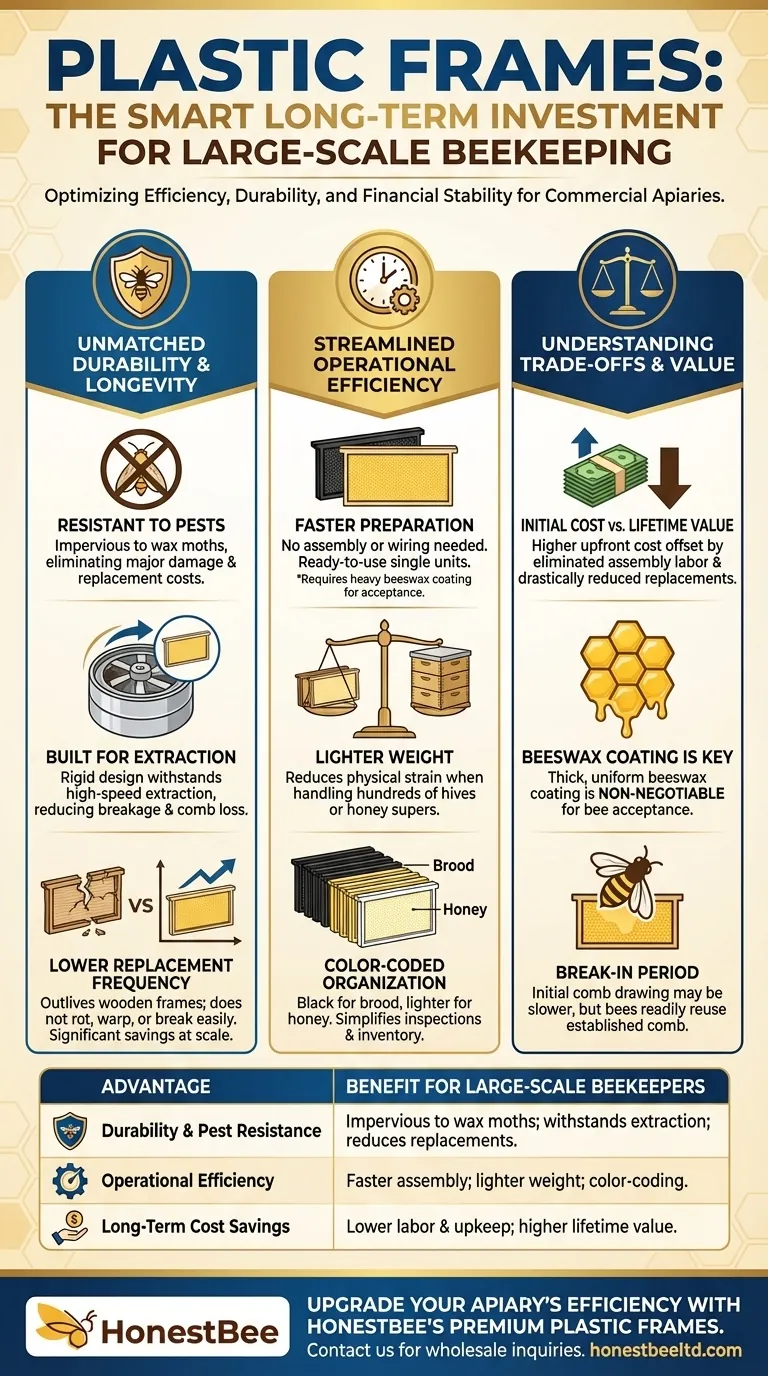For beekeepers operating at scale, plastic frames represent a superior long-term investment primarily because they dramatically reduce ongoing costs associated with labor, upkeep, and equipment replacement. Their inherent durability and resistance to common pests make them a more resilient and cost-effective choice compared to traditional wooden frames over the lifespan of a large apiary.
The decision to use plastic frames is less about the material itself and more about optimizing an entire beekeeping operation for efficiency, durability, and long-term financial stability. It is a strategic choice to minimize equipment failure and labor costs at scale.

The Core Advantage: Durability and Longevity
The primary driver for adopting plastic frames in large operations is their ability to withstand the demanding environment of a commercial apiary. This resilience translates directly into lower long-term costs.
Superior Resistance to Pests
Wooden frames are highly susceptible to damage from pests, particularly wax moths. These pests can quickly destroy comb and render wooden frames unusable, forcing costly and time-consuming replacements.
Plastic frames are impervious to wax moths, eliminating this significant point of failure and expense. This single factor provides a major boost to the longevity of your equipment inventory.
Withstanding the Rigors of Extraction
The process of honey extraction puts immense stress on frames. Plastic frames are far more rigid and durable, holding up better in high-speed centrifugal extractors without breaking or "blowing out."
This resilience means fewer interruptions during the extraction process and a much lower rate of frame failure, preserving both the frame and the valuable drawn comb.
Lower Replacement Frequency
Simply put, plastic frames outlive wooden frames. They do not rot, warp, or break as easily. For an operation with hundreds or thousands of hives, reducing the annual replacement rate has a substantial impact on the bottom line.
Operational Efficiency at Scale
Beyond durability, plastic frames streamline workflows, which is critical when managing many hives. Efficiency gains translate directly into saved labor hours and increased productivity.
Faster Assembly and Preparation
Plastic frames typically come as a single, molded unit of frame and foundation. This eliminates the time-consuming process of assembling wooden frame parts, wiring them, and embedding wax foundation.
However, for bees to readily accept them, plastic frames must be heavily coated in beeswax. Many beekeepers specify this when purchasing or apply an extra coat themselves.
Lighter Weight for Easier Handling
While a single frame's weight difference is minor, it becomes significant when lifting supers full of honey or moving hundreds of boxes. Plastic frames are generally more lightweight, reducing physical strain on the beekeeper.
Streamlined Organization with Color Coding
Plastic foundation is often available in different colors. This allows for a simple and effective organizational system that is difficult to replicate with wood.
A common practice is using black plastic foundation for brood boxes, as it makes it much easier to spot white eggs and larvae during inspections. Lighter colors like yellow or white can be reserved for honey supers, preventing cross-contamination and simplifying inventory management.
Understanding the Trade-offs
While plastic offers clear advantages for large-scale beekeeping, it's important to understand the associated considerations. Objectivity requires acknowledging potential downsides.
Initial Cost vs. Lifetime Value
The upfront purchase price of a plastic frame can sometimes be higher than a disassembled wooden frame and foundation. However, this initial cost is quickly offset by the elimination of assembly labor and the drastically reduced need for replacement over its lifespan.
The Importance of a Heavy Wax Coating
Bee acceptance is the most critical factor for any frame. Bees will be slow to draw out comb on plastic that is poorly waxed. Ensuring your frames have a thick, uniform coating of real beeswax is non-negotiable for success.
Bee Acceptance and Break-in Period
Some beekeepers observe that bees are initially slower to build comb on plastic compared to pure beeswax foundation, even when well-coated. This "break-in period" is often a one-time event, as once the comb is drawn, bees will readily use and rebuild on it in subsequent seasons.
Making the Right Choice for Your Operation
The decision between plastic and wood hinges entirely on your operational goals and scale.
- If your primary focus is maximizing long-term profitability and operational efficiency in a large-scale apiary: Plastic frames are the definitive choice due to their durability, pest resistance, and labor-saving benefits.
- If you are a hobbyist with a few hives or prioritize traditional methods over scalability: Wooden frames remain a perfectly viable option, but you must be prepared for the associated maintenance and higher replacement rate over time.
Ultimately, choosing the right equipment is about investing in a system that supports your specific beekeeping goals.
Summary Table:
| Advantage | Benefit for Large-Scale Beekeepers |
|---|---|
| Durability & Pest Resistance | Impervious to wax moths; withstands extraction stress; reduces replacement frequency. |
| Operational Efficiency | Faster assembly; lighter weight for handling; color-coding for organization. |
| Long-Term Cost Savings | Lower labor and upkeep costs; higher lifetime value despite initial investment. |
Upgrade your apiary's efficiency and durability with HONESTBEE's premium plastic frames. Designed for commercial apiaries and distributors, our frames are built to withstand rigorous use, reduce long-term costs, and streamline your operations. Contact us today to discuss wholesale pricing and how our beekeeping supplies can support your growth.
Visual Guide

Related Products
- Plastic Bee Frame Beekeeping Hive Frames for Wholesale
- Assembled Wooden Bee Frames with Plastic Foundation for Durability and Convenience by HONESTBEE
- Heavy-Duty Stainless Steel Clip-On Frame Perch
- 7 x Auto Bee Flow Hive Frames Plastic Beekeeping Hive Box Supplies
- Professional In-Hive Bee Feeder HONESTBEE Frame for Beekeeping
People Also Ask
- What are the advantages of plastic frames for beehives? Boost Apiary Efficiency & Durability
- What are the main types of frames available for beehives? Wood vs. Plastic for Your Apiary
- Are plastic bee hive frames good? A Guide to Modern Durability vs. Natural Appeal
- Are plastic frames good? Boost Apiary Efficiency with Durable, Pest-Resistant Frames
- What are the differences between wooden and plastic frames in beehives? Choose the Best for Your Apiary



















